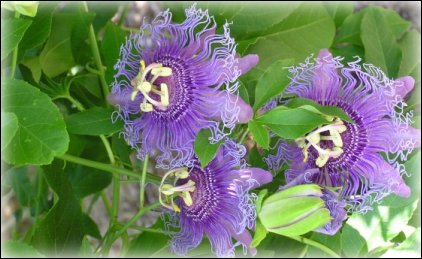For a screen, shade on an arbor, hiding a fence, or for attracting
hummingbirds and butterflies… nothing beats a vine. Fortunately
Austin’s gardeners have a world of vines to choose from. Here
are some of my favorite annual and perennial vines:
1. Annual vines
Cypress vine: this vine has tiny red flowers with delicate fern-
like leaves. It produces hundreds of flowers and thousands of
seeds, which insure its return next year. The red flowers bloom
all summer and attract hummingbirds.
Morning-glory: these vines also bloom all summer with trumpet-
shaped flowers three to four inches across. They come in a world
of colors, from reds to blues.
2. Perennial vines There are three different patterns: herbaceous,
deciduous, and evergreen.
a. Herbaceous:
Coral vine or Queen’s Crown: a beautiful, vigorous vine that can
grow 20 to 30 feet in the summer season and can be found in coral
and white. They return from tubers in the spring. Butterflies love
coral vine.
Passion vine: a beautiful and aggressive perennial vine that blooms
spring and summer with lavender to blue flowers. It is a host plant
for many butterfly species. It is not uncommon to have the vine
eaten back by butterfly larvae (caterpillars) overnight!
(pictured above)
b. Deciduous:
Chinese Wisteria is a popular spring bloomer. It produces blossoms
before foliage appears. Its large clusters (racemes) of flowers can be
found in purple, white, blue, rose, and mauve. Be sure to look for a
grafted plant because seedling-grown plants rarely bloom.
Trumpet vine is very aggressive, grows rapidly, and can attain a
height of 30 feet. It blooms in clusters of trumpet-shaped, reddish-
orange flowers that are popular with hummingbirds. This vine has
a quite the reputation for wanton destruction of wood fences and
trellises, so I suggest that gardeners choose the slightly less ram-
bunctious form called ‘madame galen.’
c. Evergreen:
Honeysuckle comes in a great variety of colors including coral,
white with yellow, purple, and pink. They all are great vines because
they are evergreen, have great drought tolerance, bloom more than
one season a year, are deer resistant, and attract wildlife. Possibly
the most popular is Texas Coral honeysuckle because hummingbirds
love it and it attracts birds as well. Best to keep this vine in the sun;
too much shade can bring on powdery mildew.
Crossvine is a tendril climbing aggressive vine that comes in tan-
gerine, red, lavender and purple. The variety known as Tangerine
Beauty has bright coral blooms which are very popular with humm-
ingbirds. Crossvine can grow in full sun and occasionally can be
found in very shady locations.
Carolina Jessamine blooms a golden yellow in late winter to early
spring. Its fragrant flowers attract hummingbirds and its dense
foliage makes a great screen. Sun to part shade is perfect for this
South Carolina native.
Confederate Star Jasmine produces masses of sweet smelling,
white blossoms in the spring with glossy dark green foliage as a
background. Star grows in sun to part shade and is often found
in full shade.
Two advantages to evergreen vines are they provide screening
throughout the year and they do not have to be cleaned off the
fence or trellis after they freeze back.


 Visit the website:
Visit the website: